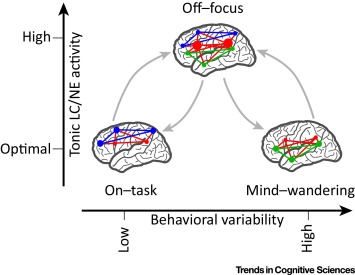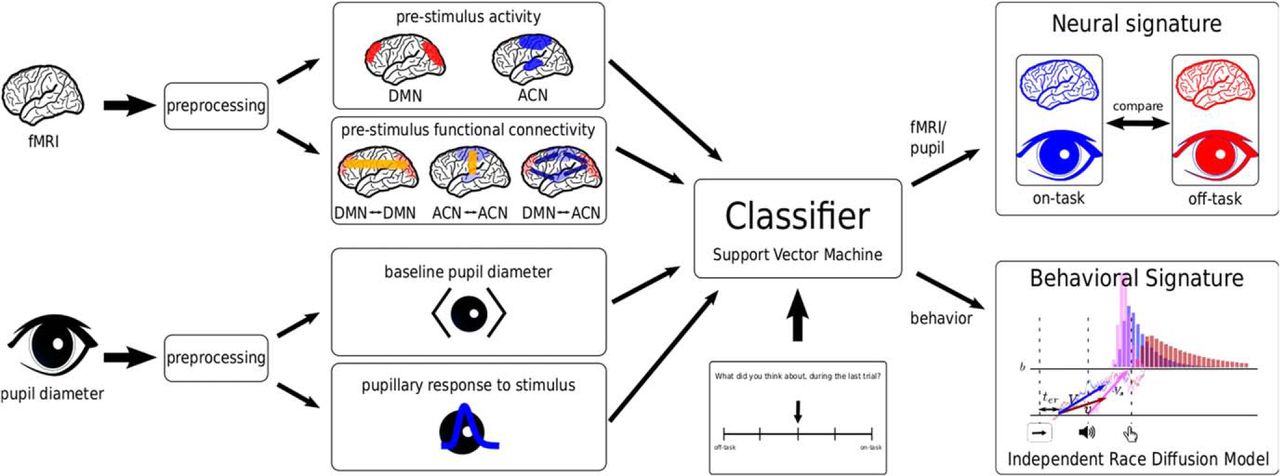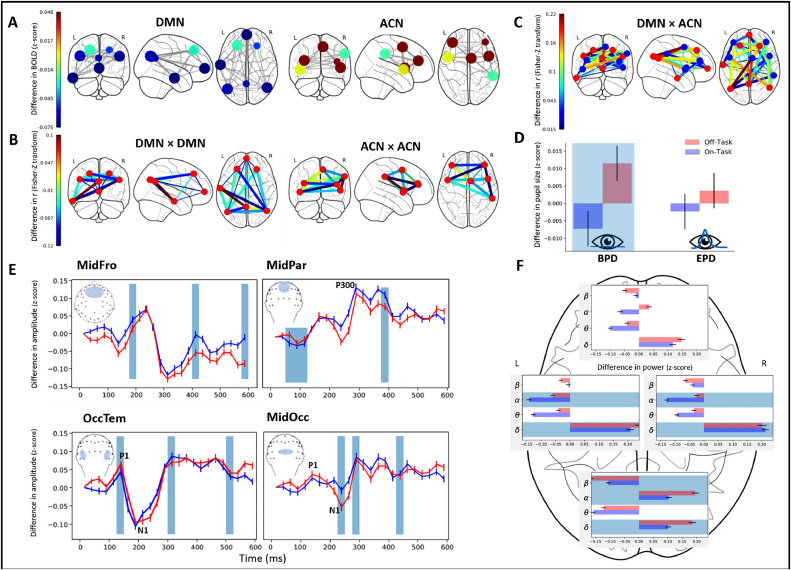In our research, we're delving into the intriguing world of inattention, those moments when our minds drift into "task-unrelated thoughts." Using advanced tools like functional magnetic resonance imaging (fMRI), we're mapping out the neural networks at play during these mental excursions. Our findings emphasize the importance of communication within and between resting-state networks, those brain regions that stay active during cognitive downtime. Broadening our approach, we're incorporating electroencephalography (EEG) and pupillometry to gain deeper insights into the neural mechanisms involved. It's worth noting our dedication to mathematical cognitive modeling in our analytical toolkit. Additionally, we're exploring the role of the subcortex using high-resolution 7T imaging.
 |
We created a model of how periods of inattention and mind wandering is initiated based on the noradrenergic system. Our model postulates a distinct "middle" stage in-between paying full attention and being fully unconcentrated. This putative state is characterized by a specific neural signature that is characterized by more exploratory neural activity. Mittner, M., Hawkins, G. E., Boekel, W., & Forstmann, B. U. (2016). A Neural Model of Mind Wandering. Trends in Cognitive Sciences, 20(8), 570–578. https://doi.org/10.1016/j.tics.2016.06.004 |
 |
We used a machine-learning approach to predict periods of mind wandering during a length laboratory task using data measured in the brain. Our algorithm achieved close to 80% accuracy in predicting when someone would not be paying attention.
|
 |
This study used a sophisticated experimental procedure in which simultaneously electrical activity and blood-flow in the brain were measured. This allowed us to characterize the neural signature of MW in great detail. Groot, J., Boayue, N., Csifcsák, G., Boekel, W., Huster, R., Forstmann, B. & Mittner, M. (2021). Probing the Neural Signature of Mind Wandering with Simultaneous fMRI-EEG and Pupillometry. NeuroImage. 224, pp. 117412 doi:10.1016/j.neuroimage.2020.117412 |
 |
In this study, we used a more complicated laboratory task compared to what is usually used in mind wandering research. We found that the self-reported and objective signatures of mind wandering can diverge strongly. Groot, J., Csifcsák, G., Wientjes, S., Forstmann, B. & Mittner, M. (2022). Catching Wandering Minds with Tapping Fingers: Neural and Behavioral Insights into Task-unrelated Cognition. Cerebral Cortex. , pp. bhab494 doi:10.1093/cercor/bhab494 |
 |
We investigated the relationship between the subcortex, an area in the brain that is situated "below" the cerebral cortex and that is severely understudied, and large-scale brain networks. To study this, we used high-resolution 7-Tesla neuroimaging. We identified several subareas that "echoed" activity from these large networks that may be important hubs organizing the dynamic flow of information through the brain.
|
Publications
- Groot, J., Miletic, S., Isherwood, S., Tse, D., Habli, S., Håberg, A., Forstmann, B., Bazin, P. & Mittner, M. (2023). Echoes from Intrinsic Connectivity Networks in the Subcortex. Journal of Neuroscience. doi:10.1523/JNEUROSCI.1020-23.2023
- Kam, J., Mittner, M. & Knight, R. (2022). Mind-Wandering: Mechanistic Insights from Lesion, tDCS, and iEEG. Trends in Cognitive Sciences. 0:0 doi:10.1016/j.tics.2021.12.005
- Groot, J., Csifcsák, G., Wientjes, S., Forstmann, B. & Mittner, M. (2022). Catching Wandering Minds with Tapping Fingers: Neural and Behavioral Insights into Task-unrelated Cognition. Cerebral Cortex. , pp. bhab494 doi:10.1093/cercor/bhab494
- Groot, J., Boayue, N., Csifcsák, G., Boekel, W., Huster, R., Forstmann, B. & Mittner, M. (2021). Probing the Neural Signature of Mind Wandering with Simultaneous fMRI-EEG and Pupillometry. NeuroImage. 224, pp. 117412 doi:10.1016/j.neuroimage.2020.117412
- Csifcsák, G. & Mittner, M. (2017). Linking Brain Networks and Behavioral Variability to Different Types of Mind-Wandering. Proceedings of the National Academy of Sciences of the United States of America. 114:30 doi:10.1073/pnas.1705108114
- Mittner, M., Hawkins, G. E., Boekel, W., & Forstmann, B. U. (2016). A Neural Model of Mind Wandering. Trends in Cognitive Sciences, 20(8), 570–578. https://doi.org/10.1016/j.tics.2016.06.004
- Mittner, M., Boekel, W., Tucker, A. M., Turner, B. M., Heathcote, A., & Forstmann, B. U. (2014). When the Brain Takes a Break: A Model-Based Analysis of Mind Wandering. Journal of Neuroscience, 34(49), 16286–16295. https://doi.org/10.1523/JNEUROSCI.2062-14.2014
- Mittner, M. (2013). Functional Integration of Large-Scale Brain Networks. The Journal of Neuroscience, 33(48):18710-18711 [link]
[Loading...]